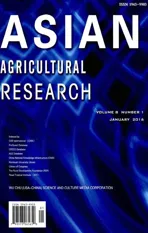Urban Residents’ Consumption Risk Perception about the Dairy Products
2016-01-11,,,
, , ,
1.Agricultural Information Institute of Chinese Academy of Agricultural Sciences, Beijing 100081, China; 2.Key Laboratory of Agri-information Services Technology, Ministry of Agriculture, Beijing 100081, China
UrbanResidents’ConsumptionRiskPerceptionabouttheDairyProducts
XiaoxiaDONG,ZheminLI,ShiweiXU*,ChaoZHANG
1.Agricultural Information Institute of Chinese Academy of Agricultural Sciences, Beijing 100081, China; 2.Key Laboratory of Agri-information Services Technology, Ministry of Agriculture, Beijing 100081, China
Based on the continuous downturn puzzle of Chinese dairy consumption, with the perception of consumption risk as a starting point, the paper deeply analyzes the main factors which cause the downturn of dairy product consumption of Chinese residents. The results show that the income elasticity of dairy consumption of Chinese urban residents is still notable; the occurrence of dairy safety incidents improves the perception of consumption risk, and accordingly it reduces the promoting role of income to the dairy consumption; the safety incident is the key factor which leads to the fall of dairy consumption of urban residents in recent years, and the perception of consumption risk of lower income group is clearly higher than that of higher income group.
Urban residents, Risk perception, Dairy consumption, Safety Incidents
1 Introduction
Dairy product, as a nutrient-rich health food, is known as the "perfect food" and "white blood". Dairy consumption has become an important indicator for the international community to measure the level of living of people[1]. According to statistics, the per capita annual consumption of liquid milk was 139.9 kg in Ireland, 106.2 kg in the Great Britain, 109.3 kg in Australia, 76.4 kg in USA, 31.6 kg in Japan and 41.3 kg India in 2012. Since 2000, the dairy product has gradually become an important food recommended by China’s government to improve dietary structure and the physical fitness of people. Over a decade, with continuous improvement of people’s living standards and the government’s emphasis on dairy development and dairy consumption, China’s dairy consumption has grown rapidly. According to the statistics, the per capita dairy consumption of urban and rural residents was 20.91 kg and 12.86 kg in 2012, respectively, with the average annual growth rate of 3.10% and 8.48%. However, compared with developed countries and some developing countries in the world, China’s dairy consumption level is still low, far below that of American and European countries, only a quarter of the world average[2]. Especially in recent years, China’s consumption of dairy products has been at low levels, and urban residents’ dairy consumption even declines significantly. Analyzing the main factors affecting the Chinese residents’ dairy consumption and improving consumption level of dairy products has become the focus of attention of the government and academia.
2 Current situation of China’s dairy consumption
Domestic and foreign studies have shown that consumer preferences, income level, urbanization level, dairy products, substitute prices and other factors affect the level of dairy consumption, and especially income level is the fundamental key factor[3-5]. In China, due to per capita income and living habits, dairy consumption has the features of "luxury goods"[6]. The study finds that during 1990-1993, the income elasticity of demand for Chinese dairy consumption was 0.40, and it increased to 1.31 during 1994-1995[7]. In 2000, International Agricultural Trade Research Center of the Chinese Academy of Agricultural Sciences studied the urban residents’ income elasticity of demand for dairy products (liquid milk 1.39; milk powder 0.38; yogurt 1.06)[8]. Zhou Junling[9]finds that during 1992-1999, Chinese urban residents’ income elasticity of demand for dairy products was 0.96, and it was higher for the low-income residents (1.24 for the lowest income resident). Thus, in theory, income level is the most fundamental factor affecting China’s dairy consumption demand. However, from the relationship between income level and dairy consumption during 2000-2012, China’s dairy consumption did not increase significantly with the increase of income. The improvement of income level promotes the sustained and stable growth of dairy consumption of rural residents (Fig. 1a), but as the main force of China’s dairy consumption, urban residents showed instable dairy consumption after 2004, and the consumption even declined after 2008 (Fig.1b). Compared with 2007, the dairy consumption of urban residents fell by 15.24% in 2012. Over the same period, the dairy consumption of residents in Beijing, Shanghai, Tianjin and other cities decreased by 16.52%. Sluggish dairy consumption has become a key constraint on the development of China’s dairy industry.
3 China’s dairy safety incidents and risk perception
3.1DairysafetyincidentsThe reason why the dairy consumption is sluggish especially for urban residents lies in the continuous dairy safety incidents in China in recent years. The dairy safety incidents are shown in Table 1. Domestic dairy safety incidents continue to occur, and consumer confidence in domestic dairy products is constantly eroded. Before the Sanlu milk powder incident in 2008, most of main domestic dairy safety incidents at home captured no attention of the government and society largely because of little impact. Even for the sensational Fuyang milk powder incident, it quickly escaped from social concern because manufacturers involved were not influential[10].

Fig.1 Income and dairy consumption
Table1Listofmajordomesticdairysafetyincidentssince2004
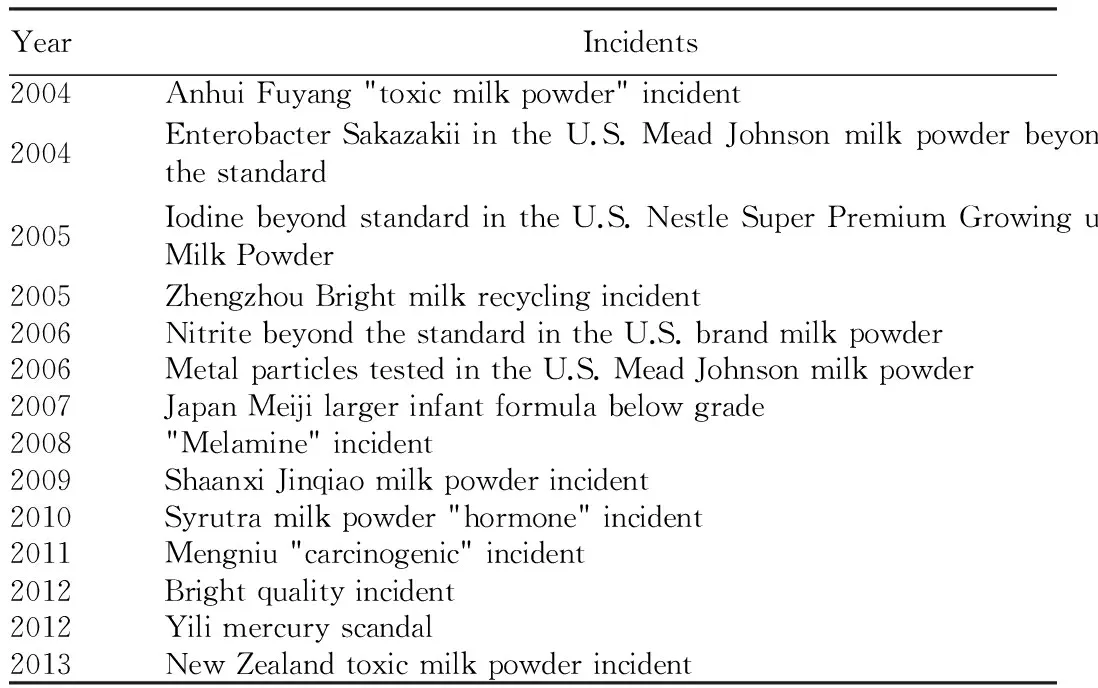
YearIncidentsPerceptionfactorsSourcesofrisk2004AnhuiFuyang"toxicmilkpowder"incidentInferiormilkpowderChemicaldisaster2004EnterobacterSakazakiiintheU.S.MeadJohnsonmilkpowderbeyondthestandardEnterobacterSakazakiiMicrobialhazards2005IodinebeyondstandardintheU.S.NestleSuperPremiumGrowingupMilkPowderIodineChemicaldisaster2005ZhengzhouBrightmilkrecyclingincidentSecondarydairyprocessingOtherdisasters2006NitritebeyondthestandardintheU.S.brandmilkpowderNitriteChemicaldisaster2006MetalparticlestestedintheU.S.MeadJohnsonmilkpowderMetalparticlesChemicaldisaster2007JapanMeijilargerinfantformulabelowgradeZincChemicaldisaster2008"Melamine"incidentMelamineChemicaldisaster2009ShaanxiJinqiaomilkpowderincidentMelamineChemicaldisaster2010Syrutramilkpowder"hormone"incidentHormonecontentChemicaldisaster2011Mengniu"carcinogenic"incidentAflatoxinMicrobialhazards2012BrightqualityincidentMilkmineralsaltsChemicaldisaster2012YilimercuryscandalMercuryChemicaldisaster2013NewZealandtoxicmilkpowderincidentDicyandiamideChemicaldisaster
Note: We classify the domestic dairy safety incidents according to the summarization of Yeung and Morris; data are sorted out by ourselves.
3.2ConsumptionriskperceptionAccording to the theory of consumer behavior, after perceiving food safety risks, consumers will be more concerned about food properties, shelf life, government regulation and other safety information, in order to avoid safety risks of food purchase. In 2000, Curtin[11]found that the sudden occurrence of food safety incident would cause dramatic changes in consumer confidence, and directly reduced consumption. In 2001, Yeung and Morris[12]made further study and found that the influence of incidents on consumer confidence was not necessarily due to consumers’ direct experience of the incidents, and the key factor affecting consumer attitudes and buying behavior of consumers in most cases is consumers’ risk perception of food safety. In the early 1970s, Roselius[13]pointed out that when consumers perceived risk, they would stop buying, reduce the purchase, consume other alternative products, or continue to buy. Among them, stopping buying or reducing the purchase is the most common method for the majority of consumers after the food safety incident, and if people perceive greater food risk and the time to stop buying is longer, there will be more reduction in the number of purchases. In 2000, Slovic[14]found that the severity of incident consequences, universality of incident consequences, control sense of risk and the level of public awareness of risk were the main factors affecting the public risk perception. Thus, for the sluggish domestic dairy consumption, we can use the dairy safety incidents in recent years for the public risk perception reasoning of dairy consumption. (i) Severity of domestic dairy safety incident consequences. According to statistics, Sanlu milk powder incident caused a total of about 294000 babies across the country to suffer excessive urinary stones due to consumption of milk powder containing excessive melamine, at least 154 babies suffered severe illnesses, and 11 babies died[15-16]. (ii) Universality of incident consequences. Since 2004, there have been many dairy safety incidents at home each year, involving many well-known brands such as Mead Johnson, Nestle, Meiji, Mengniu, Bright, Yili and Syrutra. (iii) Control sense of risk. In recent years, although the state has introduced policies and measures to guarantee the quality and safety of dairy products, the dairy safety incidents still occur, leading to the public doubt about the government ability to control dairy safety. (iv) Level of public awareness of risk. The food safety incidents can be divided into three types: microbial hazards, chemical and technological disasters. The domestic dairy safety incidents are mostly chemical disasters. The public lack proper understanding on melamine, milk mineral salts and other chemical substances, resulting in a wide gap between the objective incident risk and the subjective public risk perception. Therefore, it is considered that the dairy risk perceived by domestic consumers is high, and it is the main factor restricting China’s dairy consumption.
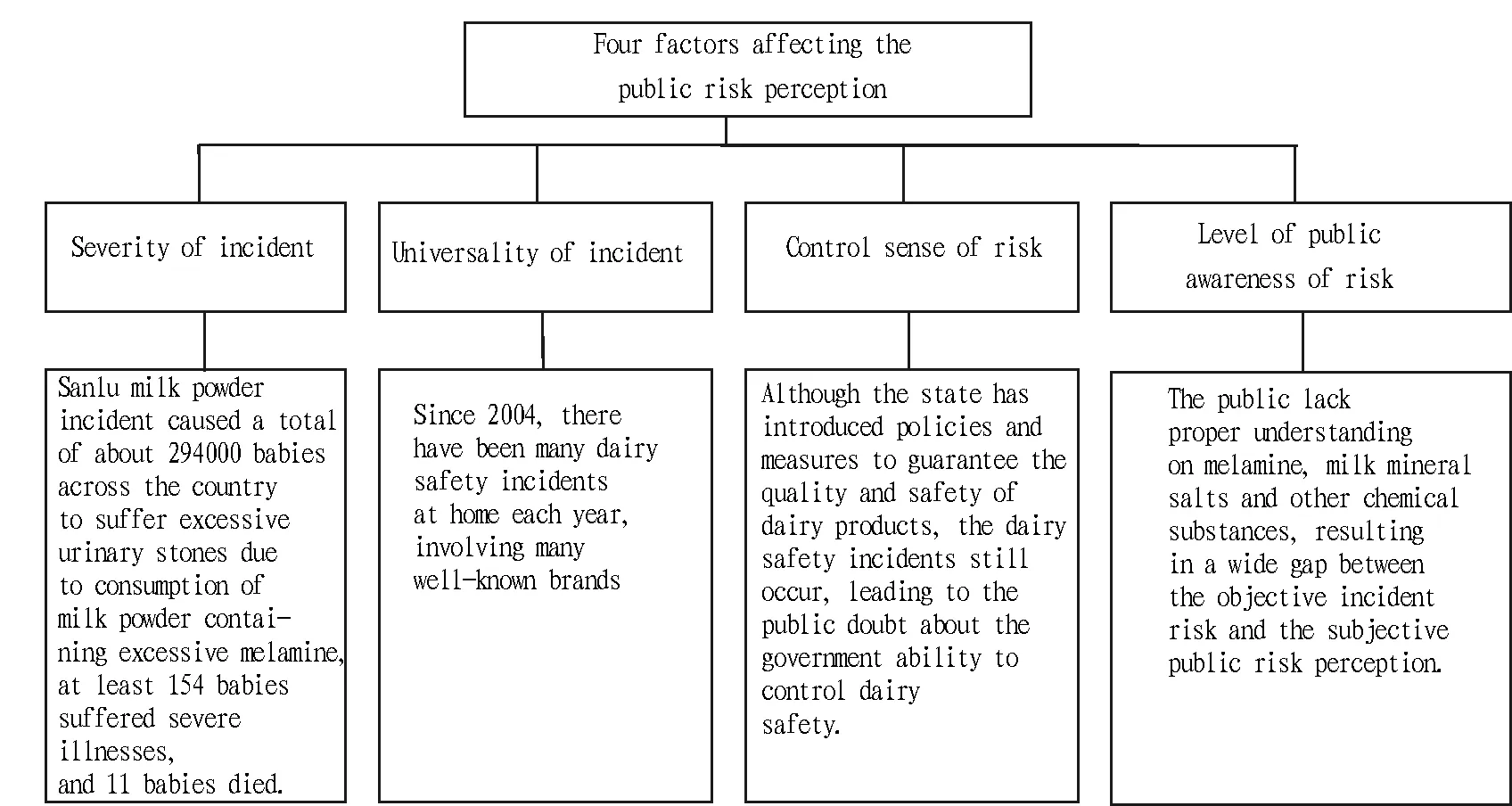
Fig.2 The public risk perception reasoning on Sanlu milk powder incident in 2008
4 The influence of dairy safety incidents on residents’ consumption risk perception
The study finally takes the Sanlu milk powder incident in 2008 for example. There were 151 reports about Sanlu incident in 2008, followed by 41 reports about Fuyang milk powder incidents in 2004[10]. The Sanlu milk powder incident in 2008 has been the most important food safety incident affecting Chinese residents’ dairy consumption risk perception in recent years.
4.1TheoreticalanalysisAccording to the market theory of neoclassical economics, the study assumes that before the Sanlu milk powder incident, the supply curve of domestic dairy products isS0, the demand curve of domestic dairy products isD0, the equilibrium point ise0. At this time, the domestic dairy product price isP0, consumption isQ0, the domestic consumer welfare isa+b, and producer welfare isc+d+f(Fig. 3). After the Sanlu milk powder incident, since the degree of domestic consumers’ risk perception on dairy consumption rises, they start to stop buying or buy less dairy products, and the dairy consumption significantly declines. The demand curve of domestic dairy product becomesD1, and in order to simplify analysis, it is assumed that the supply curve remains unchanged. The equilibrium point changes frome0toe1. The domestic dairy product price isP1, the dairy consumption isQ1, consumer welfare isb+c, and producer welfare isf. Theoretically, in this process, there isa+dnet loss of social welfare. And the producer welfare loss isc+d, the consumer welfare loss isa-c, and the loss of consumer welfare is mainly reflected in a substantial decline in dairy consumption.
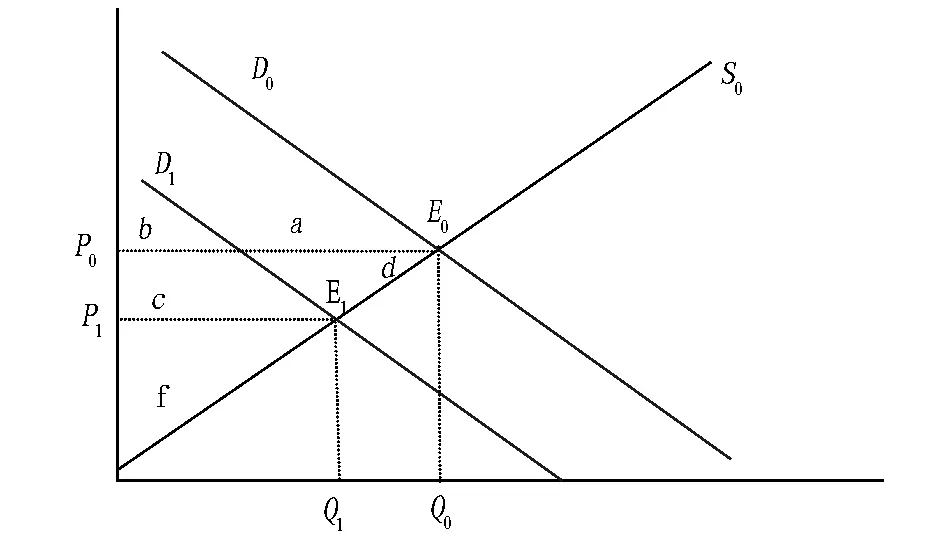
Fig.3 The theoretical influence of dairy safety incidents on China’s dairy consumption
4.2Statisticalanalysis
4.2.1Total dairy consumption change. Statistical data further confirm the results of the theoretical analysis. As can be seen from Table 2, during 2000-2004, the Chinese urban residents’ dairy consumption steadily grew, with the average annual growth rate of 14.89%, and the growth rate of yogurt and fresh milk was high, reaching 26.30% and 17.32%, respectively. The Anhui Fuyang "toxic milk powder" incident in 2004 broke this steady growth momentum. In 2005, urban residents’ dairy consumption declined for the first time, but the negative impact of this dairy safety incident was quickly eliminated. In 2006, the dairy consumption reached a record high of 25.54 kg. In 2007, the dairy consumption of urban residents underwent slight fluctuations once again. Especially with the occurrence of the most serious dairy safety incidents in recent years, urban residents’ risk perception on dairy consumption has been improved significantly, and the consumption has remained at low levels. Overall, compared with 2007, the dairy consumption declined by 8.64% in 2008, 10.94% in 2009, 16.37% in 2010, 15.24% in 2011, and 15.92% in 2012, indicating that the urban residents’ risk perception on dairy consumption is immediate, persistent and difficult to be restored.
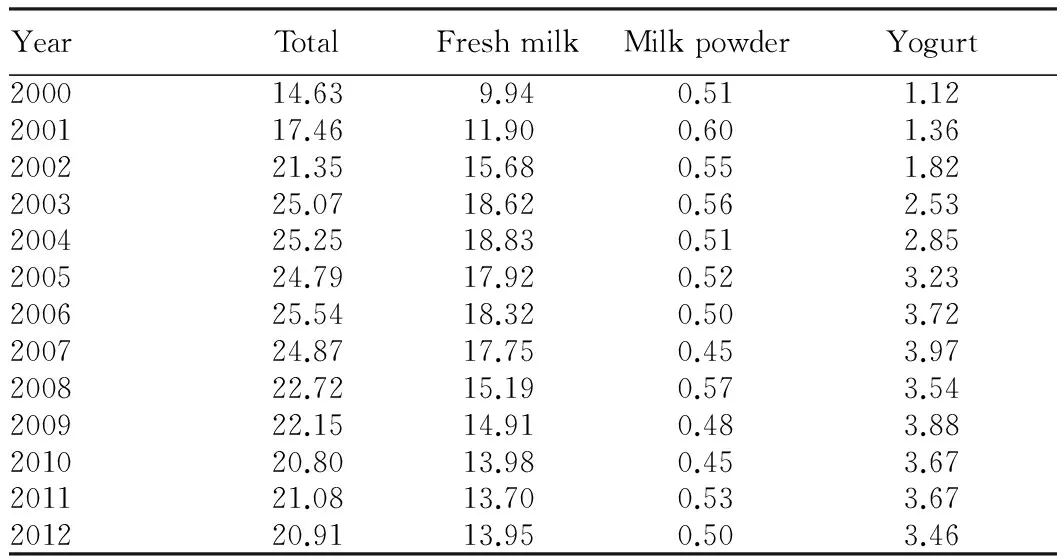
Table 2 The dairy consumption of urban residents in China since 2000 Unit: kg
Note: The data during 2000-2010 are fromChinaDairyStatisticalYearbook; the fresh milk data in 2011 are fromChinaStatisticalYearbook; yogurt and milk powder data are converted according to the residents’ dairy purchases in 36 cities inChinaStatisticalAbstractofDairyIndustry(2012).
4.2.2Consumption change of different types of dairy products. There is a big difference in the degree of residents’ consumption risk perception on different types of dairy products, and the fluctuation concerning residents’ consumption of different types of dairy products differed before and after 2008. The fresh milk consumption showed a downward trend. Compared with 2007, residents’ fresh milk consumption dropped by 14.42% in 2008, 16% in 2009, 21.24% in 2010, 22.82% in 2011 and 21.41% in 2012, with the decline level and duration higher than the overall average of dairy products. Yogurt consumption underwent a sharp decline in 2008, and rebounded in 2009, but declined again since 2010. Compared with 2007, yogurt consumption decreased by 10.83% in 2008, 2.27% in 2009, 7.56% in 2010, 8.82% in 2011 and 12.85% in 2012. The milk powder played the main role in 2008 dairy safety incidents, but the actual data show that the influence of Sanlu milk powder incident on milk powder consumption was slightest, and compared with 2007, the milk powder consumption increased by 12.27% in 2008, 6.67% in 2009, 22.22% in 2011 and 11.11% in 2012, and was flat in 2010. The possible reason for this abnormal situation is that the consumer groups of milk powder are mainly children and the elderly, and especially 0-3 year old infants have a rigid demand for milk powder. The milk powder consumption did not significantly decrease, but the consumption brands of milk powder changed, and foreign brand milk powder had an increasing market share. Before Sanlu incident in 2008, the market share of domestic brand milk powder was 60%; in 2010, the market share of imported milk powder is basically the same as that of domestic milk powder; in 2011, the market share of foreign brands exceeded 50% for the first time[17].
4.2.3Dairy consumption change of residents with different incomes. There was a large difference in risk perception on dairy safety incident between different income residents, and the degree of decline in different income residents’ dairy consumption also differed before and after 2008. Compared with 2007, the cumulative dairy consumption of the lowest income, low income, lower middle income and middle income residents decreased by 18.16%, 18.94%, 18.50 and 17.88%, respectively, higher than the total average decline of 16.37%, while the cumulative dairy consumption of the higher middle income, high income and highest income residents decreased by 13.29%, 12.04% and 11.66%, respectively, lower than the total average decline of 16.37%. Since 2011, the consumption of the lowest income residents has been improved, but the decline in consumption of the low income, lower middle income and middle income residents is significantly greater than that of the higher middle income, high income and highest income residents. This shows that the low income residents’ risk perception level on dairy safety incidents is higher than the high income residents’ risk perception level on dairy safety incidents.

Table 3 Dairy consumption change of the residents with different incomes before and after the "melamine" incident Unit: %
Note: 2008/2007 refers to the rate of consumption change in 2008 compared with 2007, and the rest can be deduced by analogy; data are fromStatisticalYearbookofChinaDairyIndustry.
4.3ModeltestIn order to quantitatively assess the impact of dairy safety incidents on domestic dairy consumption, we use the econometric model to verify the impact of food safety incidents and income on dairy consumption, and explain the lack of income elasticity in urban residents’ dairy consumption. Model is set as follows:
lnC=α+βlnI+χlnP+δD+ε
where the dependent variable lnCis the logarithm of urban residents’ dairy consumption; InIis the logarithm of urban residents’ income; InPis the logarithm of dairy products, and this paper uses the consumer price index of liquid milk and dairy products for replacement;Dis the dummy variable of melamine incident, 1 after 2008 and 0 before 2008. Sample time span is 2000-2012.
Table 4 shows the actual estimation results of econometric model by applying STATA12.0. From the model estimation results of dairy product, fresh milk, milk powder and yogurt, it can be found that the coefficient of dairy price variable is not significant, while the coefficient of income and dairy safety incidents mostly reaches a significant level, and the coefficient sign is basically consistent with the theoretical hypothesis. The model fitting coefficient also indicates that the model well reflect the main factors affecting urban residents’ dairy consumption. As can be seen from the model results, except milk powder, the income elasticity of other dairy products is significantly positive, and the elasticity coefficient of dairy product, fresh milk and yogurt is 0.5389, 0.5626 and 1.4729, respectively, indicating that income plays a significant role in promoting urban residents’ dairy consumption, that is, when urban residents’ income increases by 1%, dairy consumption, fresh milk consumption and yogurt consumption will increase by 0.54%, 0.56% and 1.47%, respectively. In the model results, except milk powder, the coefficient of dairy safety incident dummy variables is significantly negative. The dummy variable coefficient of dairy product, fresh milk and yogurt models is -0.4180, -0.5127 and -0.6572, respectively, that is, after the Sanlu milk powder incident in 2008, urban residents’ dairy consumption fell by 41.80%, fresh milk consumption fell by 51.271% and yogurt consumption fell by 65.72%. At the same time, we can see that the Sanlu milk powder incident has not significant effect on milk powder consumption. Regression results of model are very similar to the above statistical analysis results, and there is only a small difference in the decline of dairy consumption. Based on the above income variable and dummy variables of dairy safety incidents, it can be concluded that the main reason for the decline in urban residents’ dairy consumption with increasing income in recent years lies in the role of dairy safety incidents in inhibiting the increase of consumer demand. The income variable is significantly positive, which verifies the cause of the decline in actual dairy consumption less than the model coefficients that income offsets some effects of dairy safety incidents on dairy consumption.
5 Conclusions and discussions
5.1Thedairysafetyincidentenhancesresidents’consumptionriskperceptionandisthemainreasonfordeclineinurbanresidents’dairyconsumptionSince 2004, China’s dairy safety incidents have continued to occur, and especially the Sanlu milk powder incident has dealt a serious blow to domestic consumers’ consumption confidence. The urban residents’ dairy consumption risk perception level continues to increase and the dairy consumption drops significantly. In 2012, it decreased by 15.92%, compared with 2007. According to the public consumption risk perception reasoning of dairy safety incidents and econometric regression results, the study finds that the occurrence of dairy safety incidents is the major cause of declining dairy consumption of Chinese urban residents in recent years.
Table4EstimatedresultsofOLSmodel

(1)(2)(3)(4)VariableDairyproductFreshmilkMilkpowderYogurtCons-1.0042(-0.52)-1.4415(-0.65)0.1022(0.08)-10.0411(-3.56***)lnI0.5389(2.56**)0.5626(2.33**)-0.1717(-1.30)1.4729(4.77***)lnP-0.1758(-0.41)-0.1988(-0.41)0.1711(0.64)-0.5409(-0.86)D-0.4180(-2.45**)-0.5127(-2.62**)0.1016(0.95)-0.6572(-2.62**)R20.46240.44900.17090.8144AdjustedR20.28320.2654-0.10550.7525
Note: *, ** and *** represent the significance level of 10%, 5% and 1%, respectively; the consumption of dairy products refers to the total consumption of fresh milk , milk powder and yogurt.
5.2Thedairysafetyincidentshaveagreaterimpactonthedomesticdairyconsumptionbutasmallerimpactonthe"culprit"milkpowderAlthough the protagonist of dairy safety incidents in 2008 was milk powder, the occurrence of dairy safety incidents has a greater impact on the consumption of fresh milk and yogurt with domestic raw milk as source. Compared with 2007, the fresh milk consumption decreased by 21.41% in 2012, and the yogurt consumption decreased by 12.85% in 2012. For the "culprit" milk powder in dairy safety incidents, the occurrence of dairy safety incidents has a small impact on its consumption, and it did not decrease but increased by 11.11% compared with 2007. The main reason is that for milk powder, consumers can choose "foreign brand" milk as an alternative. Since 2008, the market share of "foreign brand" milk powder in China has been rising, and it occupied more than half of the market from 2011.
5.3TheriskperceptionleveloflowincomeresidentsondairysafetyincidentsishigherthanthatofhighincomeresidentsAfter the 2008 Sanlu milk powder incident, the decline in dairy consumption of the lowest income, low income, lower middle income and middle income residents is significantly higher than that of the higher middle income, high income and highest income residents, and significantly higher than the average level of different income groups. This fully shows that the risk perception level of low income residents on dairy safety incidents is higher than that of high income residents, and low income residents are largely responsible for the current decline in urban residents’ dairy consumption. This also indirectly shows that limited by educational level and ability to receive information, the risk perception level of low income residents is more obviously affected by the public opinion.
5.4TheincomeelasticityofChineseurbanresidents’dairyconsumptionisstillsignificantandimprovementofconsumptionriskperceptioneclipsestheroleofincomeinpromotingdairyconsumptionAs can be seen from the model results, except milk powder, the income elasticity of other dairy products is significantly positive, and the elasticity coefficient of dairy product, fresh milk and yogurt is 0.5389, 0.5626 and 1.4729, respectively, indicating that income plays a significant role in promoting urban residents’ dairy consumption, that is, when urban residents’ income increases by 1%, dairy consumption, fresh milk consumption and yogurt consumption will increase by 0.54%, 0.56% and 1.47%, respectively. Due to the occurrence of dairy safety incidents, residents’ consumption risk perception level is improved, and the role of income in promoting dairy consumption is eclipsed, but the income growth to some extent alleviates the decline in dairy consumption in the context of dairy safety incidents.
[1] ZHANG LX, MENG LJ. Analysis on the influencing factors of urban residents’ dairy consumption[J]. Industrial Technology & Economy,2007, 26(2):125-128.(in Chinese).
[2] ZHANG J, LI JF, LU DL. The general situation of dairy production and consumption at home and abroad[J]. Xinjiang Animal Husbandry, 2011(6):21-23.(in Chinese).
[3] Dairy Association of China. Study on the development strategy of Chinese dairy[M].Beijing: China Agriculture Press, 2005.(in Chinese).
[4] HAN GJ. Study on the development issues of Chinese dairy[D]. Wuhan:Huazhong Agricultural University, 2005. (in Chinese).
[5] WANG GR, CHEN T, WANG JJ. Analysis on the influencing factors of dairy product consumption[J].China Statistics,2009(10): 54-55.(in Chinese).
[6] JIANG NH, XIN X, YIN J. Study on the demand and supply as well as trade behavior of Chinese animal by-products[M]. Beijing: China Agriculture Press, 2003. (in Chinese).
[7] ANNING W, VINEY A. China’s dairy economy : Demand, supply and opportunities. Paper presented at the Symposium China’s agricultural trade and policy: Issues, analysis, and global consequences, June 25-26, 1999[C].San Francisco, California,USA,1999.
[8] CHENG GQ. Effect of executing WTO rule on dairy economy in China[R]. Beijing: International Trade Research Center of Agricultural Products, Chinese Academy of Agricultural Sciences,2000.(in Chinese).
[9] ZHOU JL. Study on the dairy market in China[D]. Beijing: China Agricultural University, 2001. (in Chinese).
[10] WANG Y. The medium present of food safely affair: The current situation, problems and countermeasures[J]. Modern Communication, 2010(4): 32-35. (in Chinese).
[11] YEUNG RM, MORRIS WJ. Food safety risk consumer perception and purchase behavior[J]. British Food Journal, 2001, 103(3): 170-186.
[12] CURTIN RT. Psychology and macroeconomics: Fifty-year of the survey of consumers[M]. House JS, Juster FT, Kahn RL,etal. A telescope on society survey research and social science at the university of michigan and beyond. Ann Arbor: The University of Michigan Press, 2003.
[13] ROSELIUS T. Consumer ranking of risk reduction methods[J]. European Jounral of Marketing, 1999, 33(9):911-925.
[14] SLOVIC P. The perception of risk[M]. London: Earstscan, 2000.
[15] ZHOU TY. There were about 29×104infants’ urinary system appearing abnormal for tainted milk powder[EB/OL].(2008-12-01)[2011 -01 -20]. http://news, xinhuanet.com/newscenter0008-12A)l /content一10441114一 1.htm. (in Chinese).
[16] HOU QT. A scientific analysis on food safety problems[J]. Rural Economy and Science-Technology,2011,22(3):35-36. (in Chinese).
[17] Editor of China Dairy. Foreign brand occupied half of infant milk powder market in China in 2011[J]. China Dairy, 2011(1): 76. (in Chinese).
September 18, 2015 Accepted: November 26, 2015
Supported by Agricultural Production, Market Circulation Management and Information Service Key Technology Research and Demonstration Project (2012BAH20B04); National Natural Science Foundation of China (71203221); Beijing Innovation Team Project of Dairy Industry Technology System.
*Corresponding author. E-mail: xushiwei@caas.cn
杂志排行
Asian Agricultural Research的其它文章
- Application and Residue Pollution of Mulching Films in Xinjiang
- Resource Dependence Relationship between Grass-roots Government and Farmers’ Specialized Cooperatives
- Study on the Aromatic Components of Green Plum Wine by HS-SPME-GC-MS
- Effect of Vacuum Packaging on Storage Quality of Peanut
- Innovative Development of Fishery and Ecological Protection of Poyang Lake
- Effect of Silicon Application on Rice Growth and Production Structure
